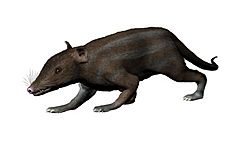Juramaia facts for kids
Quick facts for kids JuramaiaTemporal range: Upper Jurassic
160 mya |
|
|---|---|
 |
|
| Restoration | |
| Scientific classification | |
| Kingdom: | |
| Class: | |
| Subclass: | |
| Infraclass: | |
| Genus: |
Juramaia
|
| Species | |
|
|
Juramaia is a very old and important mammal that lived a long, long time ago. It's known as the earliest eutherian mammal. This means it's one of the first animals in the group that includes most mammals alive today, like humans, dogs, and elephants!
It was a small animal, a bit like a modern-day shrew. It was about 7 to 10 centimeters long. Juramaia is now extinct, meaning it no longer lives on Earth. It lived during the Upper Jurassic period, about 160 million years ago. Its fossils were found in western Liaoning, China.
Discovery of Juramaia
Scientists found a nearly complete skeleton of Juramaia. It even had part of its skull and all its teeth! This amazing fossil was discovered in a place called Daxigou in China. It came from rock layers known as the Tiaojishan Formation. Scientists have figured out these rocks are about 160 million years old.
Why Juramaia is Important
Finding Juramaia has taught us a lot about how eutherian mammals developed. It shows that our group of mammals separated from marsupials (like kangaroos and opossums) much earlier than we thought. This happened about 35 million years earlier!
This discovery also helps fill in missing pieces in the fossil record. It gives scientists better information to check their modern DNA-based methods. These methods help them figure out when different animal groups evolved.
How Juramaia Lived
Scientists looked closely at the bones in Juramaia's front legs. They found features that show it was good at climbing. This suggests that the very first eutherian mammals, like Juramaia, probably lived in trees.
Related pages
See also
 In Spanish: Juramaia para niños
In Spanish: Juramaia para niños

